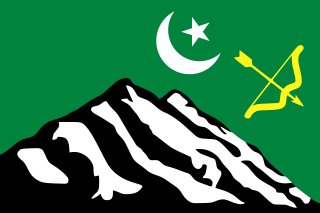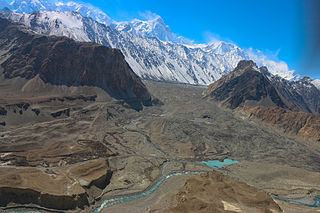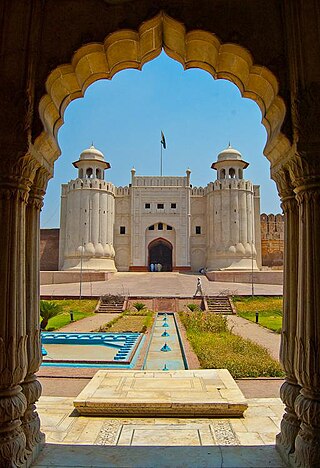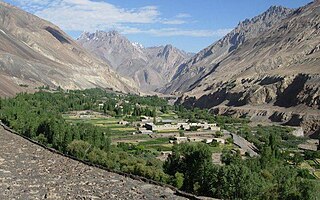
Hunza, also known as Kanjut, was a princely state in the Gilgit Baltistan region of Pakistan. Initially, it functioned as a principality and subsequently became a princely state under a subsidiary alliance with the British India starting in 1892 and continuing until August 1947. For a brief period of three months, it remained unaligned after gaining independence, and then from November 1947 until 1974, it retained its status as a princely state within Pakistan. The territory of Hunza now constitutes the northernmost part of Gilgit-Baltistan, Pakistan.

Gilgit is a city in Pakistani-administered Gilgit–Baltistan in the disputed Kashmir region. It is the capital of the Gilgit-Baltistan region. The city is located in a broad valley near the confluence of the Gilgit and the Hunza rivers. It is a major tourist destination in Pakistan, serving as a hub for trekking and mountaineering expeditions in the Karakoram mountain range.

Gojal, also called Upper Hunza, is situated in northwestern Pakistan. It borders China at the Khunjerab Pass, and Afghanistan at the Chapursan valley. In 2019, Gojal Valley became the second Karachukar sub-division within the Hunza District. It is geographically the largest subdivision of Gilgit-Baltistan.

Mir of Hunza was the title of rulers of Hunza in the Hunza Valley in the Northern Areas, Pakistan.

Nagar was a princely state located in the northern region of Gilgit–Baltistan, Pakistan. Before August 1947, it maintained a subsidiary alliance with British India. It shared its borders with the Gilgit Agency states to the south and west, while to the north and east, it bordered the princely state of District Hunza. From November 1947 to 1974, Nagar was recognized as a princely state within Pakistan, with its administrative center in the town of Nagar.

Baltit Fort is a fort in the Hunza valley, near the town of Karimabad, in the Gilgit-Baltistan region of northern Pakistan. Founded in the 8th century CE, it has been on the UNESCO World Heritage Tentative list since 2004.

The Hunza Valley is a mountainous valley located in the northern region of the Gilgit-Baltistan, Pakistan.

Altit Fort is an ancient fort in the Altit town in the Hunza valley in Gilgit Baltistan, Pakistan. It was originally home to the hereditary rulers of the Hunza state who carried the title of 'Mir', although they moved to the somewhat younger Baltit fort nearby three centuries later. Altit Fort and in particular the Shikari tower is around 1100 years old, which makes it the oldest monument in the Gilgit–Baltistan. The fort has received the UNESCO Asia Pacific Heritage Award for Cultural Heritage Conservation in 2011.

Nagar Valley once a princely state, now stands as one of the ten districts within the Gilgit-Baltistan region of Pakistan. This valley is situated along the renowned Karakoram Highway, as one travels northward from the city of Gilgit. The valley is home to many high mountain peaks including Rakaposhi (7788m), Diran Peak (7265m), Golden Peak and Rush Peak.

Tourism in Pakistan is a growing industry. In 2010, Lonely Planet termed Pakistan "tourism's 'next big thing'". The country is geographically and ethnically diverse, and has a number of historical and cultural heritage sites. Condé Nast Traveller ranked Pakistan The Best Holiday Destination for 2020 and also declared it the third-highest potential adventure destination in the world for 2020. As security in the country improves, tourism increases; in two years, it has increased by more than 300%.

The Hunza-Nagar Campaign was an armed conflict in 1891 fought by troops serving the British Raj against the princely states of Hunza and Nagar in the Gilgit Agency. It is also known in Pakistan as the Anglo-Brusho War or Jangir-e-Lae.

The valley of Punial is situated in Ghizer District in the Gilgit-Baltistan, Pakistan, where hundreds of thousands of tourists visit annually. Punial is a mountainous valley situated at an elevation of about 5000–9000 feet. The territory of Punial has an area of about 35,900 km2 (13,900 sq mi).

Oshikhandass is a village in the Gilgit-Baltistan region of northern Pakistan. It lies east of the city of Gilgit. Oshikhandass is part of the Bagrot Valley and had approximately 7,200 inhabitants in 2011. The local economy is primarily agriculture based. There are three government schools, two of which are for girls and one for boys. The village also has five private schools. Oshikhandass lies at an altitude of 1,500 metres (4,900 ft).
Gilgit-Baltistan is an administrative territory of Pakistan that borders the province of Khyber Pakhtunkhwa to the west, Azad Kashmir to the southwest, Wakhan Corridor of Afghanistan to the northwest, the Xinjiang Uyghur Autonomous Region of China to the north, and the Indian-administered region of Jammu and Kashmir to the south and south-east.

Shahid Akhtar Qalandar, commonly known by his stage name Qalandari, or Shahid Qalandar, is a Pakistani singer-songwriter born and raised in the Hunza Valley, Gilgit Baltistan, Pakistan.

The Shigar Fort also known as Fong Khar, lit. 'The Fort on the Rock' is an old fort located in the town of Shigar, Gilgit-Baltistan, Pakistan. Situated at a distance of around 30 kilometres (19 mi) from Skardu, it lies on the way which further leads to Baltoro Glacier and K2, the latter being the second highest mountain in the world.

The Sacred Rocks of Hunza or Haldeikish constitute one of the earliest sites of Petroglyphs along the ancient Silk Route. It is a cultural heritage site in Gilgit-Baltistan region of northern Pakistan. The carvings on the rocks dates back to the 1st Millennium AD.
GBA-6 (Hunza-I) is a constituency in Hunza District for Gilgit Baltistan Assembly which is represented by Obaidullah Baig.

Misgar is both a village and a valley located in the northernmost region of Pakistan. It lies on the northern edge of the Hunza District within Gilgit-Baltistan, where Pakistan shares its borders with China and Afghanistan. In recent years, Misgar has gained prominence as a starting point for a captivating trek to two Silk Road passes: Kilik Pass and Mintaka Pass, both of which lead to the Tarim Basin in China. T
Shah Salim Khan is a former Pakistani politician and entrepreneur disqualified from the Gilgit-Baltistan Legislative Assembly for having defaulted on a loan by the National Bank of Pakistan. He is the son of the 6th Governor of Gilgit-Baltistan, Mir Ghazanfar Ali Khan.



















